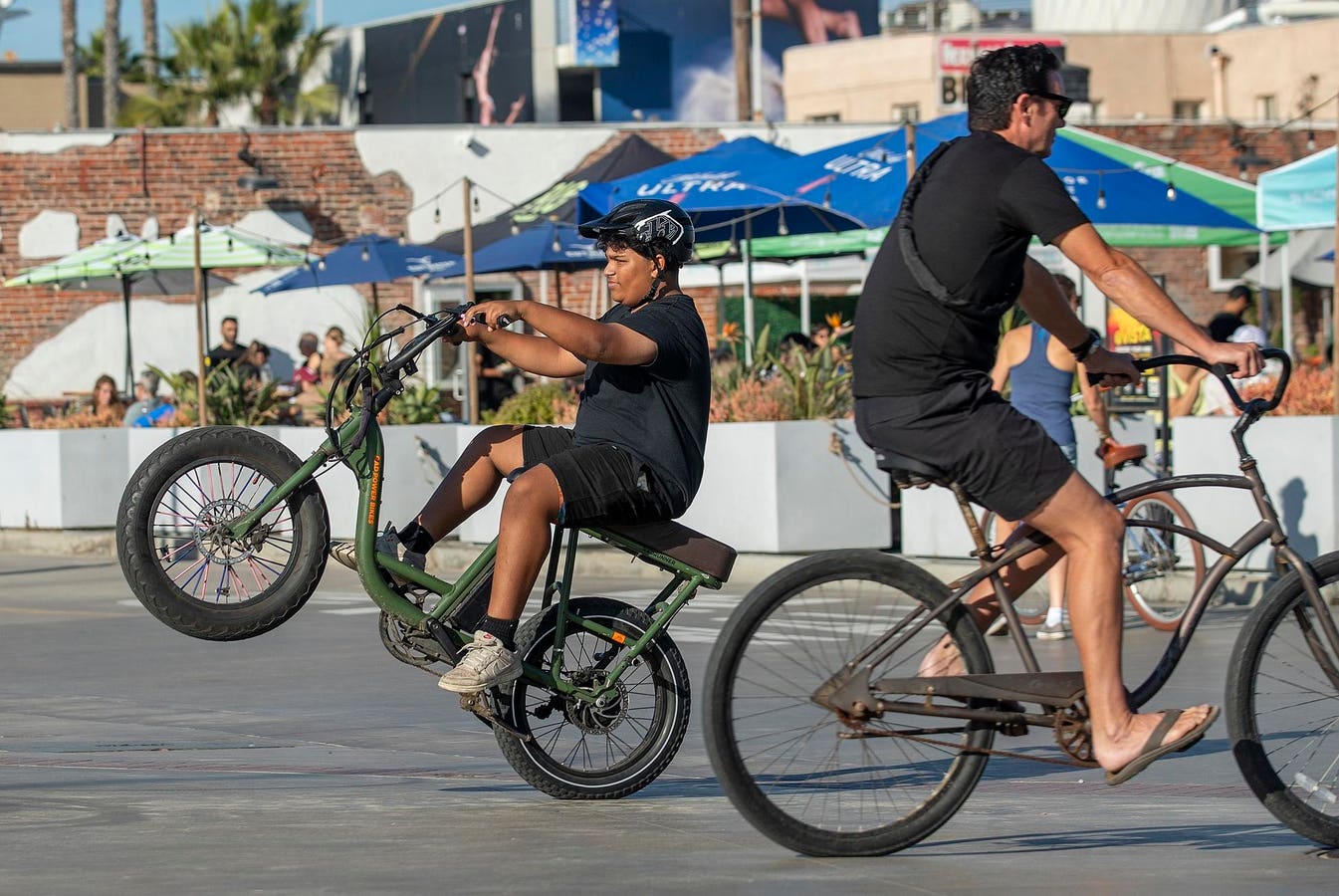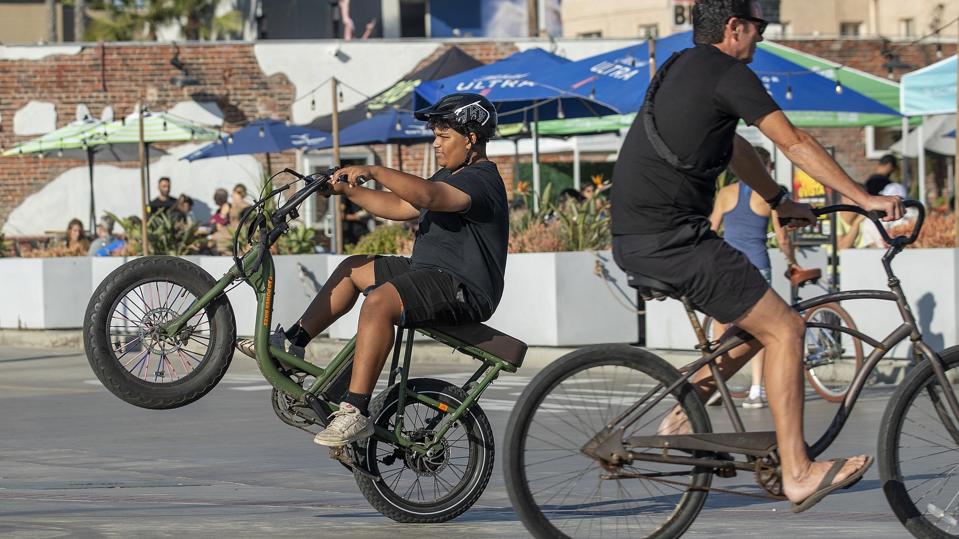Kids are increasingly riding light electric vehicles which include e-bikes, electronic scooters, electric dirtbikes and mopeds
Los Angeles Times via Getty Images
Look in your rearview mirror these days on suburban roads. You may do a double take. Is that a child zipping by on a motorcycle with no helmet? You look closely. It’s not actually a motorcycle. Maybe it’s an e-bike. Or an electronic dirt bike?
Across the country, kids and teens are increasingly riding light electric vehicles, or LEVs. LEVs are an emerging category that includes e-bikes, electric scooters, mopeds and electric dirt bikes. These battery-powered machines reach speeds of 20, 30 even >50 miles per hour.
As these vehicles proliferate, so do questions about how parents should address safety and how they should be regulated.
A Guide to Light Electric Vehicles: What They Are and Who Can Legally Ride Them
LEV is an umbrella term for a broad range of battery-powered vehicles. All are lighter and less powerful than traditional gas-powered motorcycles. But in some cases, not by much.
Kids are increasingly riding electric scooters (or e-scooters), some of which can travel faster than 20 mph
getty
Electric Scooters (E-scooters)
E-scooters are increasingly popular with kids and teens. These slim, stand-up vehicles accelerate rapidly and are simple enough for young children to operate. Many brands of e-scooters exist on the market and are available on Amazon. Popular brands include Segway, GoTrax, NIU, Emove and others. While top speeds a few years ago were limited to 10–15 mph, today many models can easily reach 20 mph or more.
Most states set a minimum age for e-scooter use between 12 and 16. California, for example, requires riders to be at least 16. Some states have no minimum. Most do not require a driver’s license or vehicle registration for e-scooters used on public roads, though some cities (like New York) require registration for faster models. Helmet use is typically required for riders under 18.
A electric bike — or e-bike — is a bicycle equipped with an electric motor to help assist with the rider’s pedaling
getty
Electric Bikes (E-bikes)
E-bikes are bicycles equipped with electric motors that assist with pedaling. They make riding easier over long distances and hills. E-bikes come in three federally defined classes, capped at 750 watts of motor output:
- Class 1: Pedal-assist only, up to 20 mph
- Class 2: Throttle and pedal-assist, up to 20 mph
- Class 3: Pedal-assist only, up to 28 mph
Brands such as Aventon, Specialized, Trek and Rad Power are stocked in bike shops while some e-bikes like Schwinn and others are available on Amazon or Walmart. Classes 1 and 2 e-bikes typically have no age or license requirements. Class 3 bikes often require riders to be at least 14–16 years old, depending on the state. Helmets are generally required for riders under 16 and for all Class 3 bikes. Bike path access is usually limited to Class 1 and 2 while Class 3 e-bikes are often restricted to roads and bike lanes. Registration is rarely required for Class 1 or 2, but some states mandate it for Class 3.
The Zero X electric dirt bike is 140 pounds, can accelerate from 0-30 mph in two seconds and tops out at 57 mph.
Los Angeles Times via Getty Images
Electric Dirt Bikes
Electric dirt bikes are high-powered, off-road vehicles with top speeds of 40–50 mph. They feature rugged tires, high suspension and motors that commonly exceed 2,000 watts, placing them squarely in motorcycle territory in terms of performance and risk. A recognizable example of an electronic dirt bike is the Sur-ron Light Bee X which can reach a speed of 46-60 mph and has a list price of $4,400.
Most states do not allow electric dirt bikes on public roads, sidewalks, or bike paths. They are typically restricted to private property or designated off-highway vehicle (OHV) trails. In states like Massachusetts and Pennsylvania, they are explicitly barred from public land use.
Electric dirt bikes generally cannot be registered for road use. Insurance is typically unavailable. While there are no age restrictions in most jurisdictions, enforcement varies—and police may issue warnings, fines, or impound the vehicle if a minor is caught riding on public streets or trails.
A moped is a small motorcycle that sometimes has pedals and typically reaches top speeds of 50+ mph
getty
Mopeds
Mopeds straddle the line between e-bikes and motorcycles. They often resemble standard e-bikes but are heavier, more powerful, and throttle-based. Many mopeds reach speeds of 50+ mph or more and may include pedals, though propulsion comes primarily from the electric motor.
Mopeds are more squarely in the light motorcycle category. Most states require moped riders to be at least 15 or 16 and to hold a learner’s permit or special license. Registration and insurance are required in most states. Helmets are mandatory for all riders, regardless of age. Mopeds are typically allowed on public roads but not on sidewalks or bike paths.
Yet there is a kid version of a moped called the Razor Pocket Mod – a retro-style electric scooter designed for kids and teens with a top speed of up to 15 mph. It costs $348 at Walmart. According to the manufacturer, it is best suited for ages 13 and up and is meant to be used on private roads or sidewalks. A smaller version The Pocket Mod Petite is marketed to children 7+ and reaches a max speed of 8 mph.
The Data: What We Know About The Safety of E-bikes And Other LEVs
Several studies have documented a steep rise in injuries tied to LEVs in children and teens. Below are a few notable ones:
- A 2024 study in the American Journal of Public Health found that between 2019 and 2022, e-bike injury rates skyrocketed by 293% and e-scooter injuries by 88%.
- A study in Orthopaedics & Traumatology, Surgery & Research reported that injuries from electric personal mobility devices were more severe than those from non-motorized ones, with higher rates of fractures and surgeries. Helmet use was absent in 88% of cases.
- A 2020 analysis of pediatric e-scooter injuries found the average age of injury was 11. Head injuries were more common than with traditional scooters (18% vs. 14%), with over 5,000 injuries treated in U.S. emergency departments that year.
- An Australian study of electric dirt bike injuries found that most patients required ambulance transport and over a quarter sustained fractures. While major trauma was rare (3%), there were several fatalities.
- Hospital admissions for scooter-related injuries increased nearly threefold between 2016 and 2020. Over half of the hospitalized patients underwent surgery, according to a study published in the Journal of the American College of Surgeons.
What Parents Can Do to Reduce the Risk Of E-bikes And Other LEVs
A young boy being taught to ride an electric bike by his older brother
getty
With injury rates rising and laws struggling to keep pace, parents play a critical role in protecting their kids.
Read the Fine Print
Before purchasing or allowing a child to ride an LEV, review the manufacturer’s specifications on speed, power and age recommendations. True e-bikes should not exceed 750 watts or 28 mph under federal guidelines. Scooters for kids should generally be capped around 15 mph.
Check Local Laws
Regulations vary widely by city and state. Some areas allow LEVs on sidewalks. Others ban them entirely. Check whether your locality requires helmets, registration, insurance or licenses.
Demand Helmet Use
Wearing a helmet reduces the risk of serious head injury by at least 53% and the risk of fatal injury by 34%, according to the American College of Surgeons. For high-speed rides, consider full-face helmets and protective gear like elbow pads, knee pads, and gloves.
Supervise and Educate
LEVs are easy to ride, but that doesn’t make them safe. Parents should set clear rules, limit riding to safe environments and supervise younger children closely.
Discourage Doubling Up
Riding two to a scooter or e-bike is both unsafe and illegal in many places. Many injuries occur when multiple children share one device simultaneously.
Ultimately electric scooters, e-bikes and other LEVs aren’t just the latest toys. They are fast, powerful machines that can cause serious harm and even death if used unsafely. Emergency departments nationwide are seeing more head trauma, fractures and life-altering injuries tied to these rides. The legal landscape remains confusing and inconsistent.
Until city, state and federal regulations catch up, it’s up to parents to understand the risks of LEVs like e-bikes and scooters, know the rules and guide their children safely. An informed adult and a well-fitted helmet may be the best protection a child can have.









